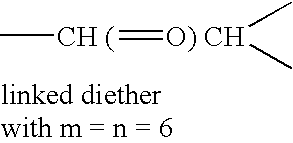Immunostimulatory, Covalently lipidated oligonucleotides
a covalently lipidated, oligonucleotide technology, applied in the direction of antibody medical ingredients, drug compositions, immunological disorders, etc., can solve the problems of backbone reducing the ability of the oligonucleotide to form a stable duplex structure, further experimentation with 3′ lipophilic modifications, and reducing duplex stability
- Summary
- Abstract
- Description
- Claims
- Application Information
AI Technical Summary
Benefits of technology
Problems solved by technology
Method used
Image
Examples
example 1
Preparation of Compound 8
[0477] To a solution of 1,2-dodecandiol (5.0 g, 24.7 mmol) and DIPEA (3.86 g, 5.2 mL, 27.7 mmol) in DCM / THF (10:1, 500 mL) was slowly added DMT-Cl solution (0.2 g, 27.2 mmol, in 100 mL DCM) over a period of 2 h at 0° C. The mixture was stirred at 0° C. for 3 h, followed by usual aqueous work-up. The product was purified by flash chromatography (hexane / ethyl acetate, 3:1) to give 8 (6.5 g, 52%). C33H44O4 (504.44). TLC: Rf=0.67 (hexane / ethyl acetate, 2:1). 1H NMR (300 MHz, CDCl3): δ 0.88 (t, J=6.5 Hz, 3H), 1.24 (br s, 16H), 1.37 (m, 2H), 2.32 (d, J=3.5 Hz, 1H, OH), 3.00 (dd, J=9.0, 7.0 Hz, 1H), 3.16 (dd, J=9.0, 3.5 Hz, 1H), 3.77 (m, 1H), 3.79 (s, 6H, 2 OCH3), 6.85-7.60 (m, 13H, Ar—H).
example 2
Preparation of Modified CPG Resin 9
[0478] Controlled pore glass (CPG) resin modified with long-chain-amino-alkyl group (lcaa-CPG) (0.6 g, 57 μmol) was treated with succinic andydride (57 mg, 0.57 mmol) in DMF (1.5 mL) overnight. Solvent was drained out and the resin washed with DMF (×5). The process was repeated once. The unreacted free amine on the resin was capped by treatment with NMI / Ac2O / THF (1:1:8, v / v / v) for 5 min. The resin was then thoroughly washed with THF (×5) and CH3CN (×5), dried under high vacuum to give the succinic acid-attached support.
[0479] The succinic acid-attached CPG resin (0.3 g, ˜28.5 mmol) was suspended in THF (2 mL) and 8 (43 mg, 85.5 μmol), DIC (14 μL), and DMAP (cat.) were added. The mixture was stirred at room temperature for 12 h. the solvent was drained out and the reaction was repeated once. The unreacted free carboxylic acid was capped by treating with methanol / DIC / DMAP for 3 h. The resin was then thoroughly washed with THF (×5) and DCM (×5), dri...
example 3
Preparation of Compound 1-5
a) De-Tritylation
[0480] Lipid-modified CPG resin 9 (0.3 g, 28.5 μmol) was treated with trichloroacetic acid (TCA) (1% in DCM, w / v) for 5 min to remove the DMT-group. The process was repeated once for 1 min, followed by thorough wash with DCM (×5), acetonitrile (×5) and THF (×3).
b) Coupling
[0481] The resin was then swelled in dry THF (2 mL), and phosphoramidite reagent (42.8 μmol, 1.5 eq.) and tetrazole (3.0 mg, 42.8 mol) were added. The mixture was bubbled with N2 gas for 16 h. After the removal of solvent and washing of the resin, the coupling with phosphoramidite was repeated once.
c) Capping
[0482] The unreacted free hydroxyl group on the resin was capped by treating with NMI / Ac2O / THF (1:1:8, v / v / v) for 5 min. followed by thorough wash with DCM, acetonitrile and THF.
d) Oxidation
[0483] The resin was then treated with 2-butanone peroxide (, 2.0 mL, 0.1 M in DCM) for 5 min. and washed thoroughly with DCM, acetonitrile, and THF.
[0484] The synthes...
PUM
| Property | Measurement | Unit |
|---|---|---|
| logP | aaaaa | aaaaa |
| logP | aaaaa | aaaaa |
| logP | aaaaa | aaaaa |
Abstract
Description
Claims
Application Information
 Login to View More
Login to View More - R&D
- Intellectual Property
- Life Sciences
- Materials
- Tech Scout
- Unparalleled Data Quality
- Higher Quality Content
- 60% Fewer Hallucinations
Browse by: Latest US Patents, China's latest patents, Technical Efficacy Thesaurus, Application Domain, Technology Topic, Popular Technical Reports.
© 2025 PatSnap. All rights reserved.Legal|Privacy policy|Modern Slavery Act Transparency Statement|Sitemap|About US| Contact US: help@patsnap.com



